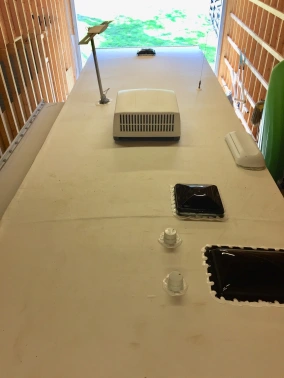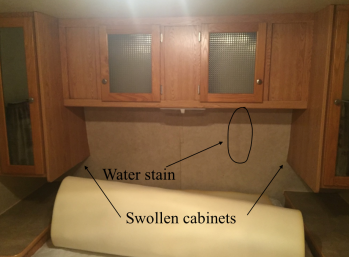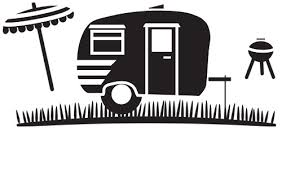 When shopping for a used RV, the most important inspection is the roof. If you fail to spend the time it takes, you could easily end up with a money pit. The cost to properly fix a major roof leak could easily exceed the value of the RV you are buying, so don’t take this process lightly!
When shopping for a used RV, the most important inspection is the roof. If you fail to spend the time it takes, you could easily end up with a money pit. The cost to properly fix a major roof leak could easily exceed the value of the RV you are buying, so don’t take this process lightly!
- Take a ladder with you and walk around on the roof. If the seller has a problem with this, they likely have something to hide. When inspecting the roof, the most suspect areas are usually the corners and above the slide out.
- Walk every square foot of the roof. Look at all corners and apply pressure to find any possible soft spots.
- Rubber evaluation While you are on the roof evaluate the condition of the EPDM rubber as well as the lap seal around antennas, roof vents, cap trim, etc. I like to use a scale of 1-10. EPDM has a 10 year useful life if left outside in the sun/elements. For this reason, the 1-10 scale works well for age and condition. The roof in the picture above is a perfect 10. It’s newly installed and kept in storage. The roof in the pictures below are a 1-2. The surface is chalky and showing large areas of black spots. These black spots are basically the bottom coating of a 2 layer EPDM. This means that the roof is nearing or past its useful life and in need of replacement. If by some miracle there weren’t any leaks during the life of this roof, an after marking roof coating product could be used to buy you some more time.
- Interior ceiling – Once you are inside the RV, look around the corners, around A/C, roof vents, skylight, etc. for any water stains, discoloration, swelling in the cabinets or around the bottom of doors.
- Use your nose! Smell is also a very good indicator. If it smells musty and damp, you likely have water damage.
- Walk every square inch of the floor including the slide-out. Look for soft spots or any repairs that don’t look original or correct. You’ll be shocked to find that extensive repairs from a roof leak can cost well into the thousands, not to mention loss of use for the months it’s being rebuilt. That said, finding a used RV without a previous leak is going to be rare, just make sure it was fixed professionally and corrective action was taken to seal the roof or exterior trim. If you find that the leak was covered up and not repaired ..RUN!
- Inspect the undercarriage. Polar packages have made it difficult to see much. Before the early/mid-2000s, most RVs likely didn’t have this option, thus making inspection of the undercarriage very easy. Aside from the polar underlining, all that is protecting the bottom of the RV is a plastic liner on the bottom of the sub-flooring. Between the liner and sub-floor is fiberglass insulation. Once a leak develops, water can get trapped between the flooring and the liner. Enough water and the liner will fill up and sag, trapping moisture in and causing huge problems. Being able to see this is impossible with the hard-plastic underpinning covering the length of the RV. My advice is to check for any recent repairs or removal of the polar lining, check for water stains or dripping around the seams. Lastly, check to see if there are any areas on the frame where the plastic attaches that holds an abnormal amount of rust. Any of these signs and it’s a good possibility you have a real problem.
- Recent RV roof coatings – If during your inspection it looks like the seller has “painted” the top of the roof with an aftermarket roof coating, you should be very wary. I am not a big fan of the products. When you have roofing material that is wet and rotten, coating the top rubber with an aftermarket product is just sealing in the moisture, filth, and rot. If you see a used RV with one of these coating products, you should ask a lot of questions. Chances are good that the application wasn’t a preventative measure. If you need a new roof, plan to pay up to $8000 to have it replaced.
Conclusion: If the roof is solid and it’s apparent that the owner kept up with the care and maintenance then you may have found a great deal! However, in the more likely scenario you find a soft spot or obvious recent repair, follow it and see if you can pinpoint how far the damage goes into the RV and ALWAYS get estimates for repairs prior to any negotiation. NEVER take advice from the seller, especially if they say they fixed it themselves. Ask more questions and consider having a reputable shop do an inspection.

Picture Note: This was the roof of a 12 year old RV that the seller claimed was stored under shelter and in pristine condition. The rubber roof is in terrible shape with the black under-layer showing in the front, cracked skylight, missing plumbing vent-cap, rubber separation around rear roof vent, and a terrible home DIY silicone seal job on the front seam. The EPDM rubber had almost completely turned to powder and had a “chalk-like” texture. When the seller added the silicon to the front cap seam all they really did was seal in moisture, furthering the problem. The front 6″-8″ of the RV roof was completely rotten and full of ants and roaches. Strangely enough, the front bedroom and bathroom looked really good with very few signs of water.
 Picture note: Doesn’t look that bad does it? From this inspection, an untrained eye would have trouble believing that the roof of this RV was completely rotten. The water had been hitting the back side of the paneling and 90% of it was flowing out of the RV between the metal front and interior panels. For this reason it could be easy to believe a seller’s statement that its a “small” leak that has been repaired.
Picture note: Doesn’t look that bad does it? From this inspection, an untrained eye would have trouble believing that the roof of this RV was completely rotten. The water had been hitting the back side of the paneling and 90% of it was flowing out of the RV between the metal front and interior panels. For this reason it could be easy to believe a seller’s statement that its a “small” leak that has been repaired.




I thought I knew quite a lot about trailers, but you’ve reeducated me. Thank you very much
LikeLike
Thanks, Farrel! Our passion is helping other RVers with inspiration and advice. We want everyone to enjoy camping the same way we do but unfortunately there are a lot of inexperienced campers that get taken advantage of and walk away from RV life. Thanks for your kind comment and for following our page! Would love to hear more feedback from you if you get time.
LikeLike
Thank you for sharing this information!
LikeLiked by 1 person
Buying a used RV that’s still in good condition can save you real money. A thorough pre-purchase inspection is crucial. Thanks for sharing the tips.
LikeLike
A well-loved RV is a well-used RV, and with use comes exposure to sun, water, and other elements. This can lead to cracks and splits in the roof membrane of your recreational vehicle over time, which can lead to costly repairs if you don’t nip them in the bud. To keep things sealed up and leak-proof, you need to use the best RV roof sealant and coating for your needs. RV Roof Magic is a product that stands out and is unique on all fronts. It not only waterproofs the roof, it blocks UV-rays and it is also not affected by ponding or standing water.
LikeLike
Buying a used RV is a great way to get the rig you’re after without spending a huge sum of money on a brand new vehicle. Sometimes a used RV can be a great buy at an affordable price. On the other hand, a used RV could be a disaster if you don’t know what to look for. Check the RV for water damage as it can be quite common on used RVs. Inspect the engine and ask the owner for maintenance records. Be sure to check all the seams for leaks. Never purchase an RV without a test drive.
LikeLike